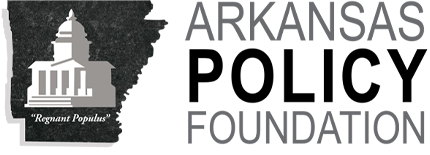INTRODUCTION
The Policy Foundation has advanced Arkansas virtual education for nearly a decade.
Virtual School Application and Charter Expansion (2002-11)
The Foundation submitted an application to establish an Arkansas virtual school for K-12 students in 2002. The application was submitted after discussions with education officials. The application was withdrawn following further discussions. The state Department of Education subsequently submitted an application for a Virtual Academy, and it was approved by the U.S. Department of Education. The Foundation observed “the Virtual Academy is one means to expand the number of charter schools in Arkansas.” The school was restructured mid-decade, and the Arkansas Virtual Academy was opened in 2007. The Virtual Academy is unique in Arkansas, and served 500 kindergarten-thru-8th grade students in school year 2010-11. The school had a statewide waiting list of 932 students in school year 2009-10 (see Appendix).
The Foundation advanced the idea that charter schools should be expanded in Arkansas. Charters were expanded in 2005, 2007 and 2011. The Arkansas Virtual Academy is structured as a charter school.
Clinton Center Conference (2010)
The Foundation sponsored a one-day forum on virtual education in May 2010 at the William J. Clinton Presidential Center in Little Rock. The forum brought together a diverse group of policymakers from across the traditional policy spectrum to discuss virtual education as a reform.
Participants included former Democratic West Virginia Gov. Bob Wise and Susan Patrick, former director of the U.S. Department of Education’s Office of Educational Technology. Wise is President of the Alliance for Excellent Education, a Washington-based group that supports virtual education as an educational reform. Patrick is President/CEO of the International Association for K-12 Online Learning in Vienna, VA.
Arkansas Virtual Academy board members, students and parents participated. Arkansas Commissioner of Education Dr. Tom Kimbrell, two state Board of Education members and community leaders also attended the forum. The Foundation published a report, The Information Economy in Arkansas: Obstacles and Opportunity to coincide with the 2010 event.
Obstacles to Virtual Education
The Foundation report linked reducing obstacles to virtual education in Arkansas with the opportunity of growth in jobs and higher income levels.
The report noted distance learning has been part of K-12 virtual education initiatives in Arkansas since the mid-1990s and a virtual school has been utilized since 2002. But the report identified serious obstacles to virtual education in Arkansas:
∙ K-8 enrollment is capped statewide at 500 students
∙ Children with medical conditions have inadequate access.
The report also noted that employment in Arkansas’ private Information sector “has barely grown in a two-decade period.” The sector is a proxy for knowledge-based industries, which Arkansas government has attempted to recruit in a high-visibility effort. The report noted:
The sector, despite adjusting for recession, has barely grown in a two-decade period. There were 17,200 Information sector employees in Arkansas in January 1990 when the employment time series began. The Information sector employed 17,800 in December 2007 at the start of the most recent recession. There were 15,400 Information sector employees in March 2010.
More than one year later (May 2011) there were 15,900 Information sector employees in Arkansas. Information employment was at lower levels in only 19 of 257 months dating to January 1990. These lower levels occurred after the Great Recession (December 2007 to June 2009). Arkansas Information employment is lower than it was at the end of the Great Recession (16,500).
Another private sector that includes jobs requiring knowledge-based skills more than doubled in the same period. Employment in Professional and Business Services (seasonally-adjusted) increased from 55,000 (January 1990) to 121,900 (May 2011), and from 53,600 to 121, 500 (not seasonally adjusted), according to the U.S. Bureau of Labor Statistics.
Arkansas officials should be wary of creating a virtual world that is at odds with the global economy’s reality of increased competition. The obstacles identified at the time of the Clinton Center forum remain in place and must be addressed. These obstacles are the virtual enrollment cap and the issue of access.
Other Obstacles to Virtual Education
The Digital Learning Council, a national group that seeks to move digital education beyond “a niche role” (Education Week, Aug. 18, 2010) was co-founded by Gov. Wise and former Florida Gov. Jeb Bush, a Republican. The Council includes government officials, business leaders and academics, and seeks to reduce other obstacles to virtual education.
The Foundation finds the issues of statewide student access, input-focused regulation, output-based regulation and opportunities for cost savings must be addressed to advance virtual education in Arkansas. These issues include:
∙ Statewide student access to credit recovery;
∙ Drop outs (through alternative schools);
∙ AP and other advanced courses;
∙ Home-bound (illness or otherwise) and home-schooled students;
∙ Unit recovery;
∙ Summer school;
∙ Disaster preparedness (H1N1 virus or other disasters);
∙ Tutoring.
Phase out input-focused regulation around the following criteria:
∙ Funding of seat time;
∙ Fixed student-teacher ratios;
∙ Geographic restrictions that limit teacher supply and student enrollment to local areas.
Output-based regulation that links funding to the ability of students to master or achieve proficiency in performance should be emphasized.
Opportunities for cost savings should be identified in these areas:
∙ Fund programs that work
∙ Eliminate or reduce transportation costs for students formerly without local access to online learning
∙ Move away from expensive textbooks
∙ Stop building large, inflexible school facilities
∙ Make professional development available to all teachers online
These additional obstacles to virtual education warrant the attention of Arkansas policymakers.
SAVINGS: The Arkansas Distance Learning Center
The Arkansas Distance Learning Center, operated by the state Department of Education illustrates the savings provided by virtual education.
The Maumelle-based Center was launched in the 2001-02 school year with 112 students. The Center’s appropriation was $2.1 million in FY 2009-10 but declined to $1.8 million (2010-11) and will drop to $1.5 million (2011-12). The average number of students served by the Center in the last three years is 3,080.1 The peak, 3,157 students, was recorded in the 2009-10 school year. This represents less than one percent of statewide Arkansas K-12 enrollment.
Rules governing distance learning were developed by the state Department of Education in 2004. The purpose is “to assist school districts in scheduling distance learning courses, make distance learning available to every Arkansas student, and coordinate distance learning calendars of course providers.” The Department is required to “work with Arkansas school districts and distance learning course providers to determine the best possible distance learning calendar(s) to meet” district’s” scheduling needs.2
The Distance Learning Consortium includes the Center and other providers. The Consortium’s operating policies are meant to promote academic success, and include guidelines that address academic dishonesty; attendance; classroom discipline, environment and facilitation; communication; computer usage; drop/add procedures; educational materials; enrollment; grade reporting; inclement weather; maintenance of records; make-up policy; parental involvement; reporting; scheduling; school dismissal; special needs; technical difficulties; technology requirements; and testing.3
Virtual education critics argue the process threatens rural Arkansas districts. PA 60 of 2003 requires consolidation or annexation of districts with enrollments of 350 students or less for two consecutive years. Yet only 20 percent of districts served by the Center (2010-11) had enrollments of 350-to-499 students. The highest enrollment percentage (42 percent) was in districts with 500-to-999 students. The remaining 38 percent were from districts with 1,000-to-2,499 students.
___________________________
1 Author interviews with Arkansas Department of Education officials.
2 http://dlc.k12.ar.us./pdf/ADE_Rules/ADE_167_Availability_Distance_Learning.pdf
3 http://dlc.k12.ar.us/pdf/Manuals/Participating_Schools/Participating_School_Handbook.pdf
The Arkansas Distance Learning Center’s curriculum is diverse, and includes the following classes in its 2011-12 course offering: 4
Accounting I
Advanced Placement (AP) Calculus
AP English Language and Composition
AP United States History, World History
ACT Prep
Algebra I and II
American Government
American History
Arkansas History
Arkansas Legal
Art I and Elementary Art
Chemistry
Chinese I and II
Civics and Civics/American Government
Creative Writing
Credit Recovery (CR) English, Geometry
Criminal Law
Drama
Economics
Environmental Science
Fashion Merchandising
Forensic Science and the Law
French I, II and III
General Music
German I and II
Human Behaviors and Disorders
International Travel
Introductory Courses
Journalism I and II
Medical Procedures and Terminology
Oral Communications
Pathology
Personal Finance
Physics
Pre-Calculus including Trigonometry
Spanish I, II and III
Sports Marketing and Entertainment
Survey of Fine Arts
___________________________
4 http://dlc.k12.ar.us/
OPPORTUNITY: The Arkansas Virtual Academy
The Arkansas Virtual Academy, operated as a not-for-profit organization illustrates the opportunity that virtual education provides students and parents. Students and parents praised the charter school at the Clinton Center Conference (2010).
The Academy’s mission statement says the school will support, guide, and assist families and colleagues in a positive way through teamwork to promote academic growth that leads to high achievement,” and will do this by keeping sight of our vision and embracing change through teamwork and good communication to assure family commitment to accomplish our purpose.”5
There is no tuition because the Academy is a public school. The curriculum is provided by K¹², a private Virginia-based curriculum provider. School materials-including books, CDs, and even bags of rocks and dirt-are delivered to the student’s place of residence. The Academy partners parents and students with an “Arkansas-licensed teacher to guide and track their progress and achievement through the curriculum.” There are frequent face-to-face meetings and events, and student-to-student interaction is emphasized.
The Academy dismisses as a “myth” the claim that “students who attend online schools lack socialization and social skills.” Students have the opportunity to participate in many academic and social outings. These outings and activities may include trips to museums, skate parks, zoos, and other public places. Another myth is the idea that students “spend all day staring at a computer.” Attendance, planning, and assessment are recorded online, but “only about 30 percent of the K-8 lessons are taught online,” according to the school. “The rest of the K¹² curriculum relies on printed and/or hands-on materials, including beautifully crafted textbooks, paint, rocks, and telescopes.”
Virtual Academy students achieved adequate yearly progress (AYP) in school year 2009-10, the second consecutive year they have achieved the goal. AYP is a metric under the federal No Child Left Behind Act of 2001. One goal of the Act is for all U.S. students to achieve proficient or advanced levels by school year 2013-14. However, the expected increase from 2009-10 to 2010-11 is substantial, according to the charter school.
___________________________
5 Arkansas Virtual Academy: http://www.k12.com/arva/home
The Arkansas Virtual Academy’s curriculum is diverse. Its curriculum6 provider includes the following classes in its 2011-12 course offering:
Advanced Earth Science
Advanced Life Science
Advanced Physical Science
Algebra 1
American History Before 1865 and Since 1865
Art (Kindergarten thru Grade Four)
Beginning Music I and II
Earth Science
Elementary French I and II
Elementary German I and II
Elementary Latin I
Elementary Spanish I and II
Exploring Music
History (Kindergarten thru Grade Four)
Intermediate Art: American A and B
Intermediate Art: World A and B
Intermediate English A
Intermediate English B
Intermediate Music 1, 2 and 3
Intermediate World History A
Intermediate World History B
Introduction to Music
Language Arts (Kindergarten thru Grade Five)
Life Science
Literary Analysis and Composition
Mathematics (Kindergarten thru Grade Five)
Middle School Chinese I and II
Middle School French I and II
Middle School German I and II
Middle School Latin I and II
Middle School Spanish I and II
Music Appreciation
Music Concepts A and B
Physical Science
Pre-Algebra A
Pre-Algebra B
Science (Kindergarten thru Grade Five)
___________________________
6 http://www.k12.com/arva/curriculum/k-8
ACHIEVEMENT: Virtual Education in ‘A’ Districts
Five ‘A’-rated Arkansas public school districts cited by the Foundation in four annual studies7 utilize virtual education. The districts are Bentonville, Fayetteville, Greenwood, Lakeside (Garland County) and Valley View.
Bentonville School District
Bentonville “is committed to providing students and teachers the technological resources necessary to enhance learning,” according to its site.8 All classrooms “have access to their own local area network, the BPS wide area network, as well as the Internet, and “leadership, support, and innovation in the use of information technologies are provided through a district-funded Technology Center.”
Teachers can accumulate staff development credits that apply to their salary schedule by attending technology classes offered by the district. Students have regular access to networked computer labs in all buildings as well as to the classroom computer. Bentonville’s goal “is multiple points of access to technology in all classrooms. We believe our students must be proficient in the tools of their generation to be successful in the Information Age.”
One goal set by Bentonville’s school board is technology training “for all staff with an increased emphasis on teacher utilization of in-class technology and applications.”
Fayetteville School District
Fayetteville provides “a number of interactive applications for parents, students, and staff which are designed to provide access to things ranging from school grades and school email to staff services and resources,” according to its site.9 Instructional applications include mathematics. Staff resources include curriculum and grade recorders and a technology inventory. District applications include a grade viewer. Staff services include professional development and technology help request applications.
___________________________
7 Foundation studies examined student performance on standardized national test (Iowa Tests of Basic Skills and the Stanford Achievement Test) in Arkansas public school districts. Studies encompassed the 2004-05, 2005-06, 2006-07, and 2007-08 school years. The Foundation recommended letter grades for districts in 1998. The state Department of Education is supposed to issue number grades for districts starting with school year 2009-10.
8 http://bentonvillek12.org/web/
9 http://www.fayar.net/
Greenwood School District
Greenwood’s site10 includes a GradeQuick login, and the district’s technology page features various links (CyberSmart Curriculum, Distance Learning Center, Internet Safety Links, Technology Infused Education, and Technology Information Center for Administrative Leadership).
Lakeside School District (Garland County)
Lakeside’s site11 posts course curriculum online. There are components for literacy, mathematics and professional development and the district’s site features various links (The Learning Institute, Tech Tuesday Classes, and NetTrekker).
Valley View School District
Valley View’s site12 includes a Gradebook Access, and an Accelerated Reader Home Connection.
___________________________
10 http://ghsweb.k12.ar.us/
11 http://lakeside.ar.schoolwebpages.com/education/district
12 http://blazers.k12.ar.us/index.htm
APPENDIX
ARKANSAS VIRTUAL ACADEMY WAITING LIST (2009-10)
Summary: More than one-third of students on the Virtual Academy’s waiting list reside in three counties: Pulaski, Benton and Washington.
More than half reside in six counties: Pulaski, Benton, Washington, Faulkner, Saline and Lonoke.
Demand for the Virtual Academy is statewide: nearly 15 percent of students on the waiting list reside in the Delta region.
| Pulaski | 176 |
| Benton | 91 |
| Washington | 75 |
| Faulkner | 62 |
| Saline | 48 |
| Lonoke | 37 |
| Garland, White | 26 |
| Mississippi | 24 |
| Sebastian | 21 |
| Jefferson | 20 |
| Polk | 19 |
| Crawford | 17 |
| Baxter, Carroll | 16 |
| Craighead | 15 |
| Union | 14 |
| Hot Spring, Van Buren | 11 |
| Johnson | 10 |
| Searcy | 09 |
| Arkansas, Cleburne, Columbia, Lee | 08 |
| Boone, Franklin, Grant, Greene, Madison, Pope, Sharp | 07 |
| Independence, Ouachita, Phillips, St. Francis | 06 |
| Ashley, Poinsett | 05 |
| Clark, Cleveland, Crittenden, Dallas, Drew, | |
| Hempstead, Miller, Newton, Woodruff | 04 |
| Bradley, Calhoun, Lincoln, Montgomery, Scott, Stone | 03 |
| Conway, Cross, Desha, Izard, Lawrence, Marion, | |
| Perry, Sevier | 02 |
| Lafayette, Little River, Logan, Nevada, Pike, | |
| Prairie, Randolph, Yell | 01 |
| Chicot, Clay, Fulton, Howard, Jackson, Monroe | 00 |
| Total | 932 |









